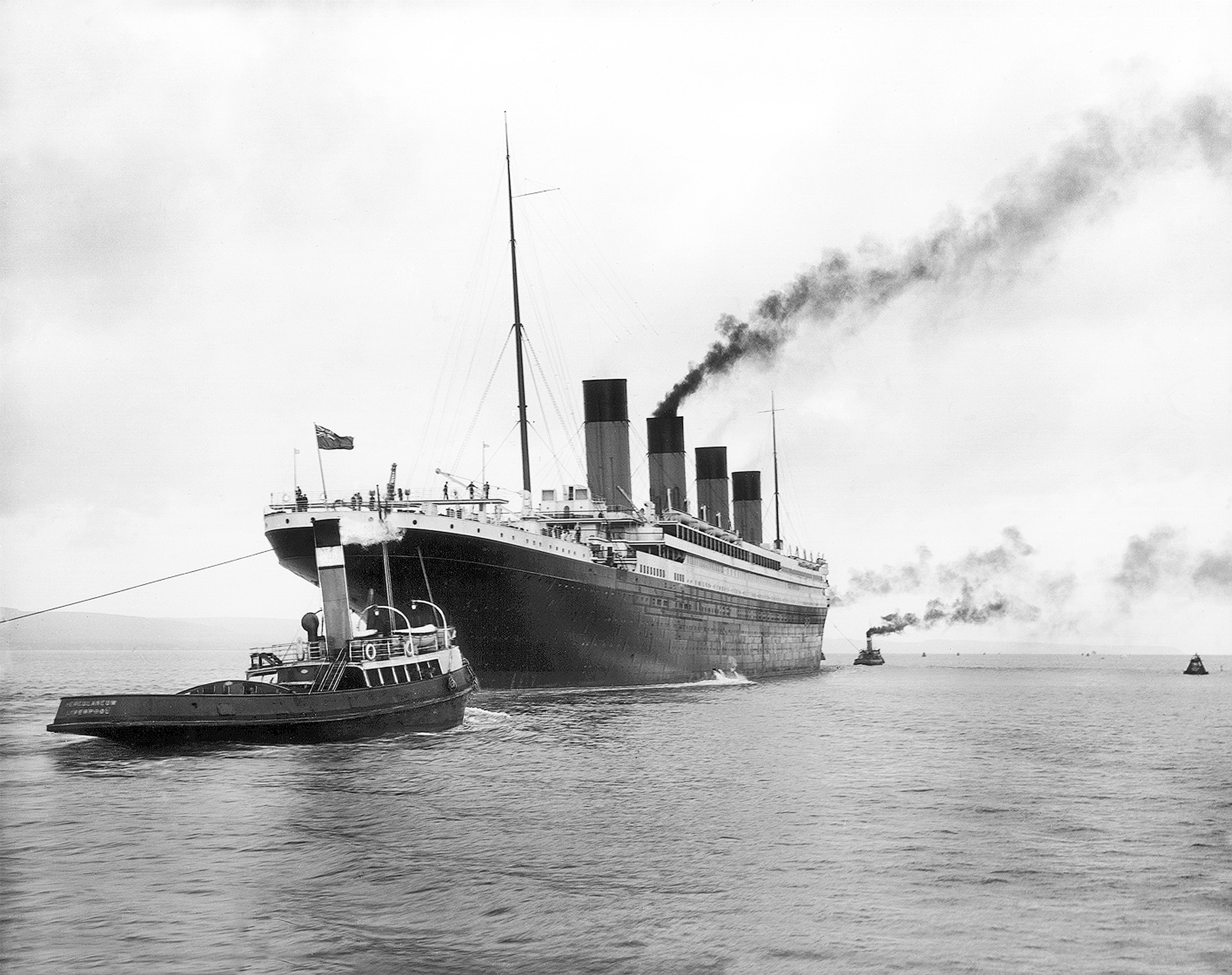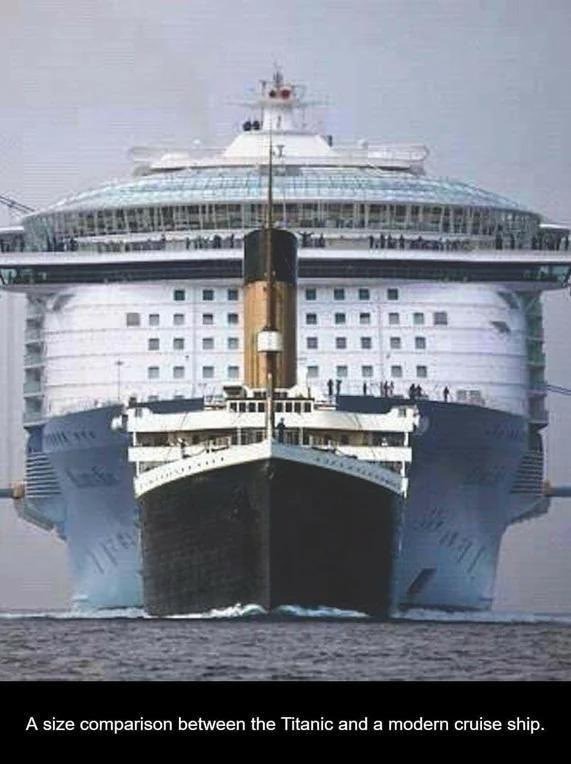The size of the Titanic compared to modern cruise ships is a fascinating topic, sparking curiosity about maritime advancements and historical contexts. COMPARE.EDU.VN offers detailed insights into these comparisons, aiding enthusiasts and decision-makers alike in understanding the scale differences. Explore the variance in length, beam, and tonnage between the Titanic and today’s vessels, gaining a comprehensive view of naval engineering progress and ship dimensions.
1. Titanic’s Size: A Historical Giant
When the Titanic set sail in 1912, it was the largest ship ever built, a title that captured the world’s imagination. Its impressive dimensions were a testament to the engineering prowess of the time. Let’s delve into the specific measurements that defined the Titanic:
- Length: Approximately 882.5 feet (269 meters). This length made it longer than any other ship of its era, a true behemoth on the seas.
- Beam: Around 92 feet (28 meters). The beam, or width, of the Titanic contributed to its stability and spaciousness, allowing for grand public rooms and comfortable cabins.
- Height: About 175 feet (53 meters) from the keel to the top of the funnels. This height gave the Titanic a towering presence, visible from miles away.
- Gross Tonnage: 46,328 GRT (Gross Registered Tons). Gross tonnage measures the internal volume of a ship, with the Titanic’s reflecting its vast interior spaces.
- Decks: 10 decks. These decks housed everything from opulent suites to cargo holds, accommodating passengers and crew in a stratified layout.
The Titanic’s size wasn’t just about numbers; it represented the pinnacle of luxury and technological achievement in the early 20th century. Its scale allowed for amenities and features never before seen on a ship, solidifying its place in history.
2. Modern Cruise Ships: Colossal Vessels of Today
Fast forward to the 21st century, and cruise ships have evolved into floating cities. Modern cruise liners dwarf the Titanic in almost every dimension, offering unparalleled amenities and experiences. Here’s a look at the typical size specifications of modern cruise ships, using Royal Caribbean’s Icon of the Seas as a prime example:
- Length: Typically ranges from 984 to 1,197.5 feet (300 to 365 meters). Many modern ships exceed the Titanic’s length by a significant margin, accommodating more passengers and features.
- Beam: Generally between 118 to 213 feet (36 to 65 meters). The increased width provides greater stability and allows for wider public spaces, such as promenades and atriums.
- Height: Often reaches up to 230 feet (70 meters) or more from the waterline. The added height allows for more decks and facilities, including water parks, theaters, and multiple dining venues.
- Gross Tonnage: Commonly exceeds 100,000 GRT, with some ships surpassing 200,000 GRT. This enormous volume indicates the vast array of amenities and spaces available on board.
- Decks: 16 or more decks. The increased number of decks allows for a greater variety of activities, entertainment, and accommodation options.
Modern cruise ships aren’t just bigger; they are designed to offer a comprehensive vacation experience, complete with amenities that were unimaginable in the Titanic’s time.
3. Side-by-Side Comparison: Titanic vs. Modern Cruise Ships
To truly grasp the difference in size, let’s compare the Titanic with a modern cruise ship, such as Royal Caribbean’s Icon of the Seas. This comparison highlights the significant advancements in shipbuilding and the scale of modern maritime engineering.
| Feature | Titanic | Modern Cruise Ship (e.g., Icon of the Seas) |
|---|---|---|
| Length | 882.5 feet (269 meters) | 1,197.5 feet (365 meters) |
| Beam | 92 feet (28 meters) | 213 feet (65 meters) |
| Height | 175 feet (53 meters) | Up to 230 feet (70 meters) or more |
| Gross Tonnage | 46,328 GRT | Exceeds 200,000 GRT |
| Decks | 10 | 20 |
| Passenger Capacity | Approximately 2,435 passengers | 7,600 |


The table clearly illustrates the massive differences in size. Modern cruise ships are significantly longer, wider, and taller than the Titanic. Their gross tonnage is also substantially higher, reflecting the increased volume and amenities available to passengers.
4. Technological and Design Advancements
The difference in size between the Titanic and modern cruise ships isn’t just a matter of scale; it also reflects significant technological and design advancements in the shipbuilding industry.
4.1. Structural Engineering
- Materials: The Titanic was constructed using riveted steel plates, a common method at the time. Modern ships use welded steel, which provides greater strength and allows for larger, more complex structures.
- Design Software: Contemporary naval architects employ advanced CAD (Computer-Aided Design) software to optimize ship design, ensuring structural integrity and efficiency.
- Stability: Modern ships incorporate advanced stabilization systems, such as fin stabilizers and anti-roll tanks, to provide a smoother ride, even in rough seas.
4.2. Propulsion Systems
- Engines: The Titanic used coal-fired steam engines, which were relatively inefficient and required a large crew to operate. Modern ships utilize diesel-electric or gas turbine engines, which are more fuel-efficient and require less maintenance.
- Propellers: Modern ships often use azipod propulsion systems, where the propellers are mounted on steerable pods, providing greater maneuverability and efficiency.
4.3. Safety Features
- Hull Design: Modern ships are designed with double hulls and multiple watertight compartments to enhance safety and prevent sinking in the event of a hull breach.
- Navigation Systems: Advanced radar, GPS, and sonar systems provide real-time information about the ship’s surroundings, reducing the risk of collisions.
- Life-Saving Equipment: Modern cruise ships carry enough lifeboats and life rafts for all passengers and crew, as well as advanced emergency communication systems.
4.4. Interior Design and Amenities
- Space Optimization: Modern ship design maximizes space utilization, creating larger cabins, more public areas, and a wider variety of amenities.
- Entertainment: Modern cruise ships offer a wide range of entertainment options, including theaters, casinos, water parks, and sports facilities.
- Comfort: Advanced HVAC (Heating, Ventilation, and Air Conditioning) systems ensure a comfortable environment for passengers, regardless of the weather outside.
These technological and design advancements have not only made modern cruise ships larger but also safer, more efficient, and more enjoyable for passengers.
5. Passenger Capacity and Comfort Levels
The increase in size directly correlates with the number of passengers a ship can accommodate and the level of comfort provided.
- Titanic: Carried approximately 2,435 passengers. The ship offered different classes of accommodation, with first-class passengers enjoying luxurious amenities while those in steerage had more basic facilities.
- Modern Cruise Ships: Can carry over 6,000 passengers. These ships offer a wide range of cabin options, from interior staterooms to opulent suites with private balconies, catering to different budgets and preferences.
The difference in passenger capacity is staggering. Modern ships are designed to handle a much larger number of people, providing a greater variety of activities, dining options, and entertainment venues. The increased space also allows for more personalized service and a higher level of comfort for all passengers.
6. Impact on Cruise Experience
The immense size of modern cruise ships has revolutionized the cruise experience, offering amenities and activities that were unimaginable in the era of the Titanic.
6.1. Variety of Activities
- Water Parks: Many modern cruise ships feature elaborate water parks with slides, pools, and splash zones, providing fun for all ages.
- Theaters: Broadway-style theaters host spectacular shows, featuring professional performers and state-of-the-art technology.
- Casinos: Large casinos offer a variety of games, from slot machines to poker tables, providing entertainment for those who enjoy gambling.
- Sports Facilities: Basketball courts, rock climbing walls, and mini-golf courses are just some of the sports facilities available on modern cruise ships.
6.2. Dining Options
- Multiple Restaurants: Modern cruise ships offer a wide range of dining options, from casual buffets to gourmet restaurants, catering to different tastes and preferences.
- Specialty Dining: Many ships feature specialty restaurants, such as steakhouses, sushi bars, and Italian trattorias, providing unique culinary experiences.
- Room Service: 24-hour room service allows passengers to enjoy meals in the comfort of their cabins.
6.3. Relaxation and Wellness
- Spas: Large spas offer a variety of treatments, from massages to facials, providing relaxation and rejuvenation.
- Fitness Centers: State-of-the-art fitness centers are equipped with cardio machines, weights, and fitness classes, allowing passengers to stay in shape while on vacation.
- Lounges and Bars: Numerous lounges and bars offer a variety of drinks and entertainment, from live music to karaoke.
The sheer size of modern cruise ships allows for an unparalleled variety of activities, dining options, and relaxation facilities, making the cruise experience more enjoyable and fulfilling for passengers.
7. Environmental Considerations
The increasing size of cruise ships has also raised environmental concerns, prompting the industry to adopt more sustainable practices.
7.1. Emissions Reduction
- LNG (Liquefied Natural Gas): Some modern cruise ships are powered by LNG, which produces fewer emissions than traditional fuel oil.
- Scrubbers: Exhaust gas cleaning systems, or scrubbers, remove pollutants from the ship’s exhaust, reducing air pollution.
- Energy Efficiency: Modern ship designs incorporate energy-efficient technologies, such as LED lighting and waste heat recovery systems, to reduce fuel consumption.
7.2. Waste Management
- Recycling Programs: Cruise ships have comprehensive recycling programs to reduce waste and conserve resources.
- Wastewater Treatment: Advanced wastewater treatment systems purify sewage before it is discharged into the ocean.
- Food Waste Reduction: Cruise lines are implementing strategies to reduce food waste, such as using smaller plates and offering more customized meal options.
7.3. Environmental Regulations
- IMO (International Maritime Organization): The IMO sets international standards for ship emissions and waste management.
- Port Regulations: Many ports have strict environmental regulations that cruise ships must comply with.
The cruise industry is committed to reducing its environmental impact and ensuring the sustainability of its operations.
8. Safety Regulations and Standards
Modern cruise ships are subject to stringent safety regulations and standards, ensuring the well-being of passengers and crew.
8.1. SOLAS (Safety of Life at Sea)
- International Convention: SOLAS is an international maritime treaty that sets minimum safety standards for ships.
- Fire Safety: SOLAS regulations require ships to have fire detection and suppression systems, as well as fire-resistant materials.
- Life-Saving Appliances: SOLAS mandates that ships carry enough lifeboats and life rafts for all passengers and crew, as well as life jackets and other safety equipment.
8.2. Stability and Hull Integrity
- Damage Control: Modern ships are designed with multiple watertight compartments to prevent sinking in the event of a hull breach.
- Stability Testing: Ships undergo rigorous stability testing to ensure they can withstand various sea conditions.
8.3. Navigation and Communication
- Radar and GPS: Advanced radar and GPS systems provide real-time information about the ship’s surroundings, reducing the risk of collisions.
- Emergency Communication Systems: Ships are equipped with satellite communication systems to ensure they can communicate with shore-based authorities in the event of an emergency.
8.4. Crew Training
- Safety Drills: Regular safety drills are conducted to ensure that crew members are prepared to respond to emergencies.
- Certification: Crew members are required to undergo specialized training and certification in areas such as fire fighting, first aid, and crowd management.
These safety regulations and standards are constantly evolving to address new challenges and ensure the safety of passengers and crew.
9. The Future of Cruise Ship Design
As technology continues to advance, the future of cruise ship design is likely to see even larger and more innovative vessels.
9.1. Larger Ships
- Economies of Scale: Larger ships can offer more amenities and activities, while also reducing the per-passenger cost.
- Engineering Challenges: Building larger ships requires overcoming significant engineering challenges, such as ensuring structural integrity and stability.
9.2. Sustainable Technologies
- Alternative Fuels: The use of alternative fuels, such as hydrogen and ammonia, could significantly reduce cruise ship emissions.
- Renewable Energy: Solar panels and wind turbines could provide a supplementary source of power for cruise ships.
9.3. Enhanced Passenger Experience
- Personalized Service: Artificial intelligence (AI) could be used to provide more personalized service to passengers, such as customized itineraries and dining recommendations.
- Virtual Reality: Virtual reality (VR) technology could offer passengers immersive experiences, such as virtual tours of destinations or simulated adventures.
9.4. Smart Ship Technology
- Data Analytics: Data analytics could be used to optimize ship operations, such as fuel consumption and maintenance schedules.
- Automation: Automation could reduce the workload for crew members and improve efficiency.
The future of cruise ship design is likely to be driven by a combination of economic factors, technological advancements, and environmental concerns.
10. Conclusion: A Tale of Two Eras
Comparing the Titanic to modern cruise ships is like comparing a vintage car to a modern SUV. Both serve the purpose of transportation, but the scale, technology, and experience are worlds apart. The Titanic was a marvel of its time, representing the height of luxury and engineering in the early 20th century. Modern cruise ships, however, are floating cities, offering a vast array of amenities and activities that were unimaginable in the Titanic’s era.
The differences in size, technology, and passenger capacity reflect the significant advancements in shipbuilding and the evolution of the cruise experience. While the Titanic remains a poignant symbol of a bygone era, modern cruise ships offer a glimpse into the future of maritime travel.
Understanding these comparisons is crucial for appreciating the historical context of the Titanic and the incredible progress made in the cruise industry. Whether you’re a history buff, a maritime enthusiast, or simply curious about the scale of modern cruise ships, the comparison provides valuable insights into the evolution of naval engineering and passenger travel.
For more detailed comparisons and objective insights into various products, services, and ideas, visit COMPARE.EDU.VN. Our platform helps you make informed decisions by providing comprehensive and unbiased comparisons. Need to compare cruise options or other travel choices? COMPARE.EDU.VN is your go-to resource.
Ready to explore more comparisons and make informed decisions? Visit COMPARE.EDU.VN today at 333 Comparison Plaza, Choice City, CA 90210, United States, or contact us via Whatsapp at +1 (626) 555-9090. Let us help you navigate your choices with confidence.
FAQ Section
1. How much bigger are modern cruise ships compared to the Titanic?
Modern cruise ships are significantly larger. For example, Royal Caribbean’s Icon of the Seas is about 315 feet longer, 121 feet wider, and has a gross tonnage that exceeds 200,000 GRT, compared to the Titanic’s 46,328 GRT.
2. What technological advancements have allowed cruise ships to become so large?
Advancements in structural engineering, propulsion systems, and safety features have enabled the construction of larger cruise ships. Modern materials like welded steel, advanced CAD software, and more efficient engines contribute to their size and stability.
3. How does the passenger capacity of modern cruise ships compare to the Titanic?
Modern cruise ships can carry over 6,000 passengers, while the Titanic carried approximately 2,435 passengers. The increased size allows for more amenities and a wider range of cabin options.
4. Are modern cruise ships safer than the Titanic?
Yes, modern cruise ships are much safer due to advanced navigation systems, hull designs, and safety regulations like SOLAS. They also carry enough lifeboats and life rafts for all passengers and crew.
5. What kind of activities can you find on a modern cruise ship that weren’t available on the Titanic?
Modern cruise ships offer a wide range of activities, including water parks, Broadway-style theaters, casinos, sports facilities, and multiple dining options.
6. How are modern cruise ships addressing environmental concerns?
Modern cruise ships are adopting sustainable practices such as using LNG, installing scrubbers to reduce emissions, implementing recycling programs, and treating wastewater.
7. What is gross tonnage, and how does it differ between the Titanic and modern cruise ships?
Gross tonnage measures the internal volume of a ship. The Titanic had a gross tonnage of 46,328 GRT, while modern cruise ships can exceed 200,000 GRT, reflecting their increased volume and amenities.
8. What safety regulations do modern cruise ships adhere to?
Modern cruise ships adhere to stringent safety regulations, including SOLAS (Safety of Life at Sea), which sets minimum safety standards for ships, fire safety, and life-saving appliances.
9. What could the future of cruise ship design look like?
The future of cruise ship design may include even larger ships, sustainable technologies like alternative fuels, enhanced passenger experiences through AI and VR, and smart ship technology for optimized operations.
10. Where can I find more detailed comparisons of different ships and cruise options?
You can find more detailed comparisons and objective insights at compare.edu.vn. Our platform helps you make informed decisions by providing comprehensive and unbiased comparisons of various products and services.
